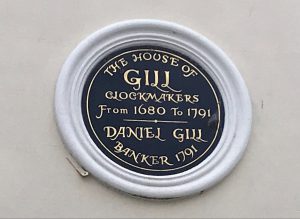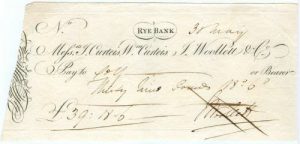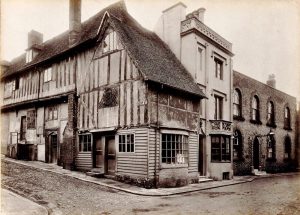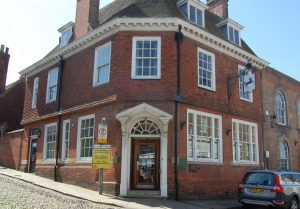The latest in a series of articles in which people involved with the Rye Castle Museum choose an object from the collection that represents an aspect of the history of the town and its environs and tell us what it means to them.
The Rye Bank blunderbuss
This month’s Rye Museum object, on display in Ypres Tower, is an 18th century gun known as a blunderbuss, chosen by Sarah Cooper, the operations manager at Rye Castle Museum.
“It’s certainly one of my favourite objects, though my connection to it and to Rye is tenuous. I’ve always wanted a blunderbuss. A neighbour where I grew up in rural Tennessee was reputed to shoot trespassers using a blunderbuss loaded with rock salt.
“See, one of the advantages of this style of gun is that you can supposedly load it with just about anything – scraps of metal, old nuts and bolts. They’re short range but they go off with a terrific roar. In this case, the gunpowder would make an almighty bang – and if it hit you, you’d surely think you were dead – but rock salt would actually be harmless. I always imagined it would sting a bit, though!”
This blunderbuss, dating from about 1750, was kept in what was known as the Rye Bank, on the corner of the High Street and West Street (later to become Lloyds Bank) hanging over the fireplace. In a recollection noted in the Burra, Curteis and Pomfret family history it describes the Rye Bank in the middle of the 19th century, and recorded the existence of the blunderbuss:
“A very curious, old-fashioned little place of business, with a blunderbuss loaded hanging over the fireplace near the bank counter – a terror to thieves!”
The blunderbuss is a firearm with a short, large calibre barrel with a flared muzzle, used with shot, a predecessor of the modern shotgun. The name blunderbuss comes from the Dutch word donderbuis, which is a combination of donder, meaning “thunder”, and buis, meaning “pipe”. It was not accurate over long distances so was used at short range, and because it was lightweight and easily handled, it was used by mounted infantry as well as pirates and naval officers involved in close-combat boarding raids. The Royal Mail coaches in the 18th century were defended from pistol-carrying highwaymen by a coachman carrying a blunderbuss. They were also known as dragons as they were often decorated with the fire-breathing creatures, and it is from this that the word “dragoon” originates as the cavalry would carry blunderbuss.
The Rye Bank blunderbuss was used to deter highwaymen when bank employees travelled between the Rye Bank and its branches in Tenterden, Lydd and New Romney (the last two only opened on one morning a week). This practice only stopped in 1893 when the bank was bought out.
History of the Rye Bank
Rye had several bankers, also involved in other trades and professions in the 18th century. In 1790, Daniel Gill, a clock and watch maker and silversmith with a shop at 101 High Street (today still marked by a plaque to him) opened a private bank. His partners were Jeremiah Curteis (a solicitor, landowner, and the Rye town clerk who bought Leasam House in 1790 but never lived there, instead living at Bank House where the library now is), William Curteis, John Woollett and Weeden Dawes. John Woollett’s home was in the whole 11 High Street, which included the building that was previously the HSBC bank building (now the Ryebank Gallery), a large garden, the gazebo and the Cinque Ports Street car park.

On May 27, 1814, a notice in The London Gazette noted the dissolution of the partnership of Jeremiah Curteis, William Curteis, John Woollett, Weeden Dawes and Daniel Gill of the Rye Bank. Their successors were Richard Curteis, William Croughton, John Butler Pomfret (from an Ashford banking family), Thomas Pix and Daniel Gill. This also became known in 1826 as Curteis, Pomfret & Co and from 1866 onwards various members of the Burra family, who had married into both the Pomfret and Curteis family, joined the Rye Bank.

The Rye Bank had branches in Tenterden, Lydd and New Romney. It was authorised to issue £29,864 and cheques were issued in the bank’s name from 1814 to 1890.
In 1893, the Rye Bank, who had its premises in the much-changed building which is now Herrington’s Solicitors opposite the library (still known as Bank Chambers) and had extended into the house next door to the east, was absorbed into Lloyds Bank.

In 1895, Lloyds left the present solicitors building and bought the old cottages on the corner of the High Street and West Street, immediately demolishing both them and the house. A new Gothic-style building replaced them and this was replaced by another rebuild in 1920 (see date on the guttering) which is the one we see today.

Lloyds, along with the NatWest and Barclays Bank branches, have now closed and are being redeveloped, ending the presence of banks in the town.
The Rye Castle Museum has two sites, one in a former bottling factory in East Street and the other at the Castle / Ypres Tower.
Castle / Ypres Tower is open daily throughout the year. March 30 to October 31 from 10:30am to 5pm. November 1 to March 29 from 10:30am to 3:30pm.
East Street is open at weekends from April to October from 10:30am to 4:30pm (subject to availability of volunteers).
Image Credits: Rye Castle Museum , Nick Forman , Coincraft , Kenneth Bird .



